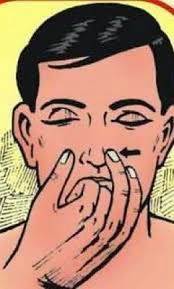This is the simplest and best pranayam.
Method: Sit in Padmasana, Siddhasana or
Sukhasana. Exhale completely through both nostrils. Close the right
nostril and slowly take a deep breath through the left nostril. This
inhalation is called Poorak. Now, hold the breath for as long as
possible. This is known as Abhyantar Kumbhak. Then close the left
nostril and exhale slowly through the right nostril. This process is
called Rechak. After Rechak, hold the breath out for as long as
possible. This is called Bahya Kumbhak. Now, inhale through the right
nostril, hold it for some time and then exhale slowly through the left
nostril. After completely exhaling, hold your breath out for some time.
This entire process is one pranayam. The ratio of the duration of
Poorak, Abhyantar Kumbhak, Rechak and Bahya Kumbhak should be 1:4:2:2
respectively. That is, if you take ten seconds to inhale, retain the
breath for 40 seconds. Exhale over a period of 20 seconds and remain
without breath for 20 seconds. These are the ideal proportions. With
regular practice over a period of time, one can easily attain this model
proportion.
Sukhasana. Exhale completely through both nostrils. Close the right
nostril and slowly take a deep breath through the left nostril. This
inhalation is called Poorak. Now, hold the breath for as long as
possible. This is known as Abhyantar Kumbhak. Then close the left
nostril and exhale slowly through the right nostril. This process is
called Rechak. After Rechak, hold the breath out for as long as
possible. This is called Bahya Kumbhak. Now, inhale through the right
nostril, hold it for some time and then exhale slowly through the left
nostril. After completely exhaling, hold your breath out for some time.
This entire process is one pranayam. The ratio of the duration of
Poorak, Abhyantar Kumbhak, Rechak and Bahya Kumbhak should be 1:4:2:2
respectively. That is, if you take ten seconds to inhale, retain the
breath for 40 seconds. Exhale over a period of 20 seconds and remain
without breath for 20 seconds. These are the ideal proportions. With
regular practice over a period of time, one can easily attain this model
proportion.
One should ideally spend 20 seconds in Poorak, 80
seconds in Abhyantar Kumbhak, 40 seconds in Rechak and 40 seconds in
Bahya Kumbhak. Mental recitation of mantra done during Kumbhak is
immensely beneficial. The Pranayam, thus performed simultaneously with
jap is known as Sabeej (with seed) pranayam. Begin with 5 to 7 such
pranayams and gradually increase this number to at least ten to perform
them regularly.
seconds in Abhyantar Kumbhak, 40 seconds in Rechak and 40 seconds in
Bahya Kumbhak. Mental recitation of mantra done during Kumbhak is
immensely beneficial. The Pranayam, thus performed simultaneously with
jap is known as Sabeej (with seed) pranayam. Begin with 5 to 7 such
pranayams and gradually increase this number to at least ten to perform
them regularly.
Benefits: The breathing becomes regular,
rhythmic and extremely subtle with the practice of this pranayam; and
the aspirant registers rapid spiritual progress apart from making
tremendous gains on the health front. This pranayam relieves mental
tension. Pessimism is replaced by optimism. One is filled with joy,
enthusiasm and fearlessness.
rhythmic and extremely subtle with the practice of this pranayam; and
the aspirant registers rapid spiritual progress apart from making
tremendous gains on the health front. This pranayam relieves mental
tension. Pessimism is replaced by optimism. One is filled with joy,
enthusiasm and fearlessness.
Bhramari Pranayam
The word ‘bhramri’ has been taken from the voice of humming bee because in this
pranayam our voice resembles with that of a humming bee.
Method
This pranayam should be done while sitting in either sukhasna or padmasna. Bhramri
Pranayam procedure has been divided into three parts:
Poorak: take deep breath from the nose during this stage.
Kumbhak: these are of two types-
Internal (Abhyantar) kumbhak
External (Bahya) kumbhak
We
stop breath after inhaling in internal kumbhak and in external kumbhak,
we stop breath after exhaling. Always do internal kumbhak after poorak
and gradually increase the duration of internal kumbhak after regular
practice.
stop breath after inhaling in internal kumbhak and in external kumbhak,
we stop breath after exhaling. Always do internal kumbhak after poorak
and gradually increase the duration of internal kumbhak after regular
practice.
Rechka:
Insert your middle finger in both of the ears and vibrate them. Now,
while producing the sound of ‘Om’, exhale slowly and thus, bhramri music
will be produced. The duration of rechak should be almost double than
that of poorak.
Visit http://vedicmemory.com/foreign-online-training-on-mind-power-stress-release/
Your Helping Guide
Virender Mehta

No comments:
Post a Comment